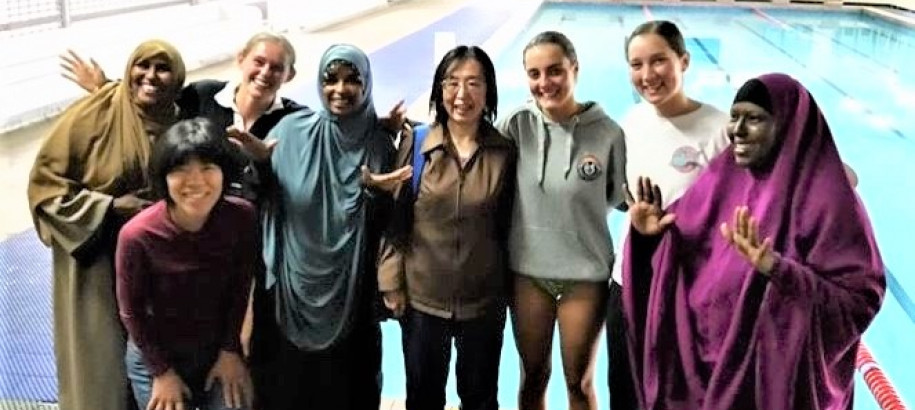
Ella Keogh first witnessed the challenges faced by members of culturally and linguistically diverse communities who want to learn to swim, when she was teaching a class at the Melbourne University facilities. One of the participants wore a hajib and clothing in the water because she was at a public pool and the water-logged, heavy material made the lessons difficult for her.
It led Ella to investigate how she could create an environment that would be appropriate for female members of CALD communities and make them feel at ease.
She approached neighbourhood learning centre, Farnham Street, which works closely with refugee communities, and found that there was a need for this. Many pools provided times when women could use the pools in privacy, but these were often late at night, which made it difficult for those with children, and, particularly concerning for Ella, these were rarely when swim teachers were available.
“There was the opportunity to go to the pool in an environment that was culturally appropriate but not the opportunity to actually learn how to swim,” she said.
Her response was to find a way to do both. So, she developed a learn-to-swim program for women that was held during the day at Melbourne University Propulsion swim club that encouraged participation among Melbourne’s CALD communities.
The classes, which have been running during summer for the past three years, proved popular with women from Somalia, Vietnam, China and Lebanon. The goal of the program was to provide a safe space for the women so they felt comfortable to fully participate and reach a level where they could save themselves if they got into trouble.
Why was this important? A Royal Life Saving Australia Report provides the sobering answer. It found that 762 people, who were born overseas, drowned in Australia between 2005 and 2015. This made up 27 percent of total drownings and included recent arrivals, long-term residents, international students, those on work trips and tourists.
Surf Life Saving Victoria’s most-recent annual Drowning Report also states that 14 of the 40 people who died in the state’s waterways during the 2017-2018 year were from CALD communities. This was a staggering 75% increase on the 10-year average.
The circumstances in which immigrants to Australia previously lived may have given them little access to pools or waterways, let alone exposure to water-safety messages or learn-to-swim programs. Some have arrived from war-torn regions or land-locked countries where the ability to swim is simply not a priority and certainly not the rite of passage that it is regarded as in Australia.
“Then once you’re here there’s not an opportunity,” Ella said. “If you need to be in a hijab and fully clothed before you can swim that’s going to be pretty hard.”
Ella said the teachers had also learnt a great deal from the program, including realising they had not fully appreciated the depth of fear that many participants felt about being in the water.
It was the main reason why Linda Guerra Clemente could not swim despite having some lessons when she lived in Portugal.
“My fear is that somehow I won’t be able to swim, and I will drown, so if I swim in a pool where I can stand up (then) I can swim. If I move further out and I get tired or can’t swim I think I will drown,” Linda said.
“It takes time for people to lose fear and gain confidence. The more I practise the more confident I will be.”
Linda did not rush back to the pool when she arrived in Australia, waiting a couple of years before she joined a Farnham Street program in Essendon and, while she was still working to improve her swimming, she would not have reached the current level without it.
“I’m very grateful to the program because it gave me an opportunity I probably wouldn’t have had because of a lack of initiative in some respects,” she said.
“Compared to where I was at the beginning to what I am now, I am much better.”
Ella, who was elected to the Swimming Victoria Board last year, wants to see more programs introducing swimming to people of all backgrounds. It is, after all, a sport that helps build community spirit and improved fitness and general health. However, lowering costs and becoming more attuned to the needs of CALD communities could also lead to untapping a new talent source for swimming.
She said she had noticed a change in attitudes in recent years among the younger generations of CALD communities. They are being introduced to swimming at school, and she sees greater opportunities of recruiting youth to the sport through mentoring programs.
“It’s a lifetime sport and it creates a community all through your life. There are fun events you can do, it’s very engrained in the Australian community with the beach and that sort of thing and including more people in that should be a priority,” Ella said.
“Making it more accessible can only drive competition. These communities, when given the resources, are going to be fantastic competitors. Why would we not want to improve our competition base?
“... You can see in the AFL, with Aliir Aliir and Majak Daw coming through, they’re just so athletic and so talented ... it is a shock to me that we do not have more athletes from these communities already. I definitely see that happening in the coming years in all sports not just swimming.”
For more information on the program click here or contact ellakeogh@gmail.com.
